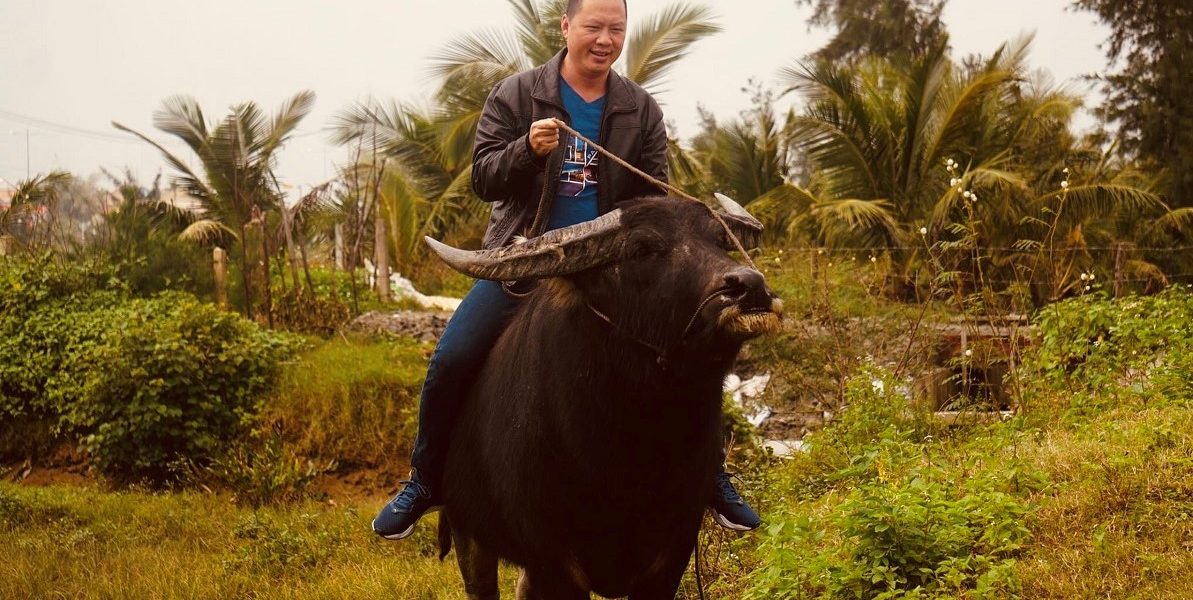
Many households in coastal town Hoi An have been offering buffalo tours for over a decade, earning a decent income.
Buffaloes in Vietnam, a top exporter of rice in the world, play a vital role in agriculture. Possessing a robust and sturdy body along with a rather calm character, they help farmers plough their fields.
Before the Covid-19 pandemic hit, Le Nhien, 48, from Thanh Tay area of Cam Chau Ward, central Vietnam’s Hoi An with his well-trained buffaloes often welcomed tens to hundreds of curious visitors each day. After receiving a tour request from an agency, he would shower and clean his buffaloes one day prior to meeting customers.
A 30 to 60-minute buffalo tour usually consists of five minutes traversing grasslands or swamps, allowing visitors to lose themselves in the serene landscape, have a casual chat with farmers and listen to work songs.
Buffalo tours bring him VND14-15 million ($607-651) a month, much more than cultivating rice.
“I can earn a good sum of money to pay for my children’s education and afford basic needs,” said Nhien.
Nhien recalled that during the very first days he had noticed his buffaloes appearing timid and experiencing allergic reactions to the exotic perfumes of tourists. This prompted him to apply perfume on his hands to let them familiarize themselves with the fragrance once back in the stable.
After a few years, he gradually grew emotionally attached to each buffalo, giving them names based on their character like Lu, Pho, Binh and Xe. A qualified buffalo, according to Nhien, should be more than three years old and friendly enough to be ridden and approached by strangers.
Nhien started training his buffaloes as calves to respond to basic commands like go straight ahead, stop, turn left, turn right and reverse.
The farmer also has the chance to communicate with people from all around the world, commenting that foreigners whom he has met are “nice and kind-hearted.”
In Vong Nhi Village, Cam Thanh Ward, Hoi An, 69-year-old Pham Nhi, owner of a vast 7,200-square-meter farm and four buffaloes, also makes a good living out of this service, offering additional home cooked meals. He earns VND12-13 million a month.
According to a tourism officer of Cam Thanh Ward, there are four households with a total of 12 buffaloes in the ward offering such tours.
He said thanks to the services, the households could earn VND60-100 million ($2,600-4,300) per year, much higher than income from mere farming.

|
|
Rhon Adams and her daughter gently touch the buffalo with “dreamy” eyes. Photo courtesy of Le Nhien. |
Rhon Adams, a tourist from the U.S, said after the tour: “My daughter and I had a wonderful opportunity. We were able to meet the farmer and his buffalo.
“She’s [the buffalo] absolutely amazing and beautiful, kind, gentle. The area is absolutely gorgeous and farm life there is just amazing. I highly recommend this for anyone who comes to Hoi An.”
Global travel restrictions due to Covid-19 have seen Nhien’s 20 buffaloes temporarily return to the field, where they remain under strict care should tourism make a future comeback.
“I love them like my own children because they work hard to support the family. During the pandemic, they are back on their feet helping us with farm work,” he added.
Since the coronavirus outbreak hit Vietnam in Feb. 2020, Nhi only got to welcome two groups of tourists, with the latest Tet (Lunar New Year) holiday plans canceled. He said the virus was causing him a hard time.
The progenitor
Thirteen years ago, Tran Van Khoa, director of Jack Tran Tours, visited every nook and cranny in idyllic wards of Hoi An like Cam Thanh, Cam Ha, An My, Cam Chau to find partners to operate buffalo tours. At first, it was not easy to convince farmers who had been toiling in the fields all their lives.
It took Khoa three years to sufficiently instruct buffalo owners and build tours. In 2010, patience and hard work paid off, with the first tours officially rolled out.
 |
|
Khoa rides a buffalo. Photo courtesy of Tran Van Khoa. |
Khoa said the idea came to him when he realized that visitors from developed countries like the U.K, the U.S. or New Zealand found the image of humans working alongside buffaloes in the field refreshing.
“To me, nothing beats the image of buffaloes ploughing the field to help farmers grow rice and feed the whole country. I usually tell tourists I am proud of Vietnam and our wet rice agriculture,” he said.
Khoa considers this a win-win situation for both farmers and tourists. There are around 2,000 to 3,000 visitors a year that participate in these tours.
Due to Covid-19, inbound tourism is witnessing periods of inactivity but buffalo tours are attracting domestic visitors, especially families with kids from big cities like Hanoi and Ho Chi Minh City coming to experience rural life.
Khoa’s company offers various daily life exploration tours in Hoi An including fishing, fishing village adventures or basket boat rides. A tour typically costs $25-50 per guest.
